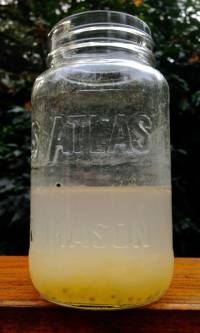Table of Contents
Savings seeds
I seldom save seeds from our vegetables. Exceptions are:
- Leeks (once, anyway)
- One variety of tomato
Of course, the seeds I do collect are from open-pollinated varieties.
Selection
I save seeds for only one variety of tomato. It is not commercially available, as far as I know. The main reason is that this variety, TPS Golden tomato, mentioned elsewhere, has shown unusual resistance to late season blight. It's a plus that this golden is a beautiful tomato (by shape and coloring) and it has most appealing flavors.
I am selecting first for blight resistance, so I collect seeds from tomatoes on plants that have not been affected by blight and whose fruit has not been tainted. Other characteristics seem common to all the fruit, except I avoid collecting from the smallest tomatoes.
Except in the hoop house I have isolated TPS Golden from other varieties to avoid possible cross-pollination. In the future I will scrupulously isolate the Goldens.
Standard method
 I use a method generally recommended by master gardeners, fermenting the seeds to separate them from the gel. This:
I use a method generally recommended by master gardeners, fermenting the seeds to separate them from the gel. This:
- helps sort out bad seeds (good seeds sink, bad ones float to the top)
- reduces some seed-borne illnesses
- eliminates a germination inhibitor
Here's the procedure:
- Cut the tomato into several pieces
- Scoop out the seeds and gel into a small container
- Add 1/4 to 1/2 cup of water and set the container aside, out of the sun, for 3 to 5 days.
- A moldy film forms on top. That’s okay.
To separate the seeds:
- First carefully remove the film.
- Add more water and stir (good seeds have sunk)
- Carefully pour off the water and the floating bits of pulp (repeat until all the pulp is gone and you have clean seeds)
- Drain them as well as possible (using a paper towel helps)
- Spread them in a single layer on a screen or a paper plate to dry. (The medium needs to wicked away the moisture. Seeds tend to stick to a paper towel but don’t use a plastic or ceramic plate.)

 I leave the seeds to air dry for a couple of weeks. Then I put them into a paper envelope and store in a cool, dry, well ventilated place.
I leave the seeds to air dry for a couple of weeks. Then I put them into a paper envelope and store in a cool, dry, well ventilated place.
Reasons not to
I don't generally save seeds because:
- Most must stay planted long after I am preparing my garden for the next season
- Many are easily affected by cross-pollination with other varieties
- Some dry out only very slowly in the cloudy, humid conditions of fall and winter
- In most cases it is more trouble than it is worth
- Often plants gone to seeds are unsightly
- A variety of professionally grown, open pollinated seeds are available and relatively inexpensive
Some of the above are reasons why I don't take locally saved seeds at a seed exchange. (I still remember the “turnip seeds” that were a really a mixture a radish and who knows what!)
